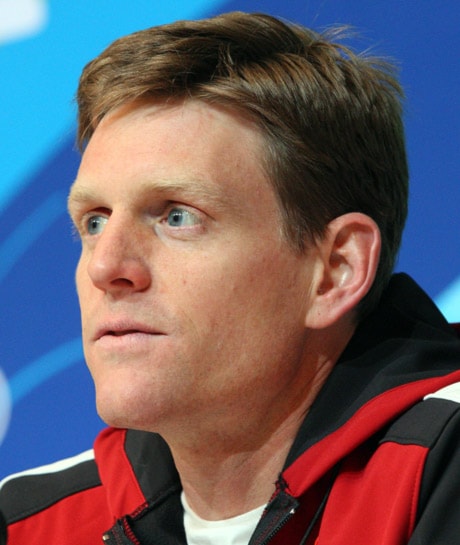WHISTLER, B.C. — Canadian Jeff Pain says his German skeleton competitors are illegally attaching magnets to their sleds to propel them faster down the course.
“I don’t know 100 per cent how they use it. My belief is they’re creating a magnetic field that provides dampening (or) shock-absorbing,” the 39-year-old Calgary slider, a two-time Olympian, told a news conference Wednesday.
“I know it’s around the runner post on their sleds,” he said, referring to the area near or on the metal runners that contact the ice.
“If you read the rules it says no electromagnetic fields. That’s how I would define (the magnets),” he added. “Obviously the FIBT disagrees with me or they haven’t found it, (but) it would be nice to have that investigated a little bit.”
The FIBT — short for Federation Internationale de Bobsleigh et de Tobogganing — is the sport’s governing body and will inspect and sign off on sleds during the Olympics.
Don Krone, head of communications for the FIBT, said none of the German sleds have flunked race specifications this World Cup season.
“I’ve been at every World Cup race in the last 13 seasons and I’ve never heard any mention of magnets. That doesn’t mean it’s not an issue,” said Krone. “We will certainly look into the matter.”
Krone declined to comment on whether magnets are specifically banned on the sleds, saying he’ll need to talk to FIBT materials experts for clarification, all of whom were in transit Wednesday en route to the Whistler event.
A German team official wasn’t immediately available for comment Wednesday. But earlier this season, team coach Raimund Bethge denied allegations of cheating.
Bethge also tongue-in-cheekily suggested that given Montgomery won the World Cup event in Cesana, perhaps it’s his sled that should be tested.
The skeleton races run Feb. 18-19 at the Whistler Sliding Centre.
Questions over the German sleds have been bubbling below the surface on the skeleton World Cup circuit this season.
They broke to the surface in December at Winterberg, Germany, when Canadian slider Jon Montgomery publicly wondered how the German stars could be fatally slow in the push off — jumping into their sleds — yet somehow find the speed down the course to finish on the podium.
“I raised the question of their technology,” said the 30-year-old from Russell, Man., when asked Wednesday to revisit the comments.
“I suspect that they (the sleds) are completely legal, just superior in technology,” said Montgomery.
The difference, he said comes when the Germans fly off the optimum drive line down the course. Their sleds dig in, fight the ice and the G-forces to get back on track, yet are whisper-quiet.
“You can see them break out and skid and you don’t hear them, whereas when we break out and skid you can hear us destroying the ice,” he said.
The Germans are famous for sparing no expense to give athletes a competitive edge. In Berlin, the famous FES Institute tests, measures and builds prototypes to harmonize athletes and equipment at elite-level sports. It was believed to be the driving force behind the powerful East German sports machine.
“I think we’re behind the game a bit and the Germans do have superior sled technology and runner technology to ours, but it’s only a little bit and it doesn’t mean the difference between winning and losing,” said Montgomery.
Tech wars have become a key component in skeleton, where athletes slide stomach-down on fibreglass and metal sleds on chutes of ice at well over 130 km/h, and where winners and losers can be separated by 12-hundredths of a second -— the blink of an eye.
This season, German slider Frank Rommel is ranked second and teammate Sandro Stielicke third in the overall FIBT rankings, which determine seeding at the Olympics.
Martins Dukurs of Latvia is first. Montgomery is the top Canadian in fifth.
Pain won silver at Turin in 2006, after finishing sixth in Salt Lake in 2002. He will retire after Vancouver.
Germany has never won an Olympic medal in skeleton, which as a sport, is a century old but has had limited exposure at the Olympics. It was held on the Cresta Run at St. Moritz in 1928 and 1948, but then disappeared until it returned to the Games for good in 2002.
Mellisa Hollingsworth of Eckville, Alta., won the World Cup women’s event this year and is ranked No.1 going into the Games.
The Eckville, Alta., slider said she has not heard of any skulduggery, but admitted she really isn’t looking for it.
“The way I do my sport is not the same as how other people approach it,” said the 29-year-old, who leaves her sled to her sled builder.
“The way that I slide, I use my feeling and I have to believe in myself and not concern myself with anybody else — whether that’s their equipment, their start times, their down times. And that’s how I’ve been successful to date.”
